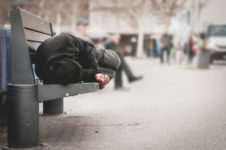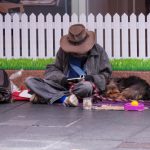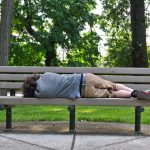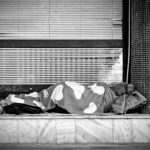Homeless Lives Matter: Governments Must Focus on Charity at Home

A homeless man has been charged with bashing 27-year-old homeless woman Courtney Herron to death in a Melbourne Park over the weekend.
Ms Heron, who suffered a mental illness and problems with drugs, had been sleeping rough and couch surfing. She, and the man who has been accused of murdering her, are part of a growing population of Australians who do not have safe homes to go to, and are falling through the cracks of strained social services system that’s unable to provide help.
The extent of homelessness in Australia
On Census night 2016, 116,427 people were counted as being homeless. This translates, to a rate of homelessness of about 50 for every 10,000 people, up five percent on the previous count in 2011.
Of course, the problem with the Census, is that it only counts people who actually fill in their personal information. For this reason, the Australian Bureau of Statistics supplements census statistics with data from a variety of field workers, accommodation providers and boarding houses to provide a more robust count of homeless people. But it’s unlikely that the number reflects the true extent of the problem.
In particular our youth, and people over 55 are experiencing the fastest growing rates of homelesses around the country. And the problem is that homelessness is not a short-term issue that is easily fixed.
Homelessness is vastly complex and there are many reasons why people find themselves homeless, including domestic and family violence, poverty, long-term unemployment, economic and social exclusion, as well as severe mental illness and addictions.
At the crux of the issue is a chronic shortage of affordable housing around the country.
The need for affordable housing
Many economists agree that there is a clear link between a rise in homelessness and a rise in housing prices. But on top of that, stagnant wages and a raft of changes to welfare over several years have meant that many people just can’t afford what should be considered a basic need – a roof over their heads.
In terms of social housing – Australia has nowhere near enough to cope with current demand and waiting lists can be years long. Currently there are about 200,000 Australians on the waitlist. Those ‘lucky’ enough to get a placement, rarely leave, so the system stays permanently ‘full’ with only few and very occasional vacancies.
The rise in homelessness has been particularly sharp since 2011, and it has made homelessness a lot more visible, particularly in our major cities. When confronted with the growing problem in Martin Place, in the Sydney CBD, the NSW government passed legislation specifically aimed at moving these people out of a place that for many had meant a rare sense of safety and security at night. Victoria has responded in a very similar way to homeless people in and around its CBD. Both states have the highest population of homeless people at 37,715 and 24,817 respectively.
Homeless people are more likely to be victims of crime
Homeless people are far more likely to be victims of crime than others, as the brutal death of Courtney Herron shows. These are people who desperately need help – not just to get a roof over their heads but long-term assistance so they can turn their lives around.
Last year, Launch Housing released The Australian Homelessness Monitor – the
first national longitudinal study of homelessness in Australia, commissioned in conjunction with the University of NSW and the University of Queensland.
The study put the blame for homelessness squarely at the foot of the government. It’s lack of investment in social housing, inadequate policy and a failure to increase social security benefits at a crucial time in Australia’s economic development. While property prices increased 80%, median household incomes rose only 40%.
The study found that people relying Newstart and the Youth Allowance in particular are at the greatest risk of homelessness and housing stress.
Is help really on the way?
In its 2017 budget, the federal government allocated $375 million over three years to frontline services as part of the National Housing and Homelessness Agreement. And while there is undoubtedly a strong need to boost frontline and crisis services, in many ways it is akin to dressing a gaping wound with a band aid. Many homeless Australians are already caught in the web of duress and uncertainty, shuffling between housing emergency, private rentals, couch surfing, and rough sleeping, a cycle that can perpetuate for years without providing much in the way of real help.
While the experts say that change needs to tackled with a multi-faceted approach, it also must begin with an alteration of societal attitude, in particular a marked change in the way we talk about the issues of poverty and homelessness which are inextricably linked.
Currently, we have a Premier who openly declared that the homeless people in Sydney’s CBD were making her ‘feel uncomfortable’, and over decades we’ve heard the rhetoric from politicians who have introduced measures to ‘clamp down’ on ‘dole bludgers’ and ‘welfare rorters’, showing absolutely no respect for the fact that the vast majority of people who experience homelessness and poverty don’t do so by choice and need the help of governments, not further stigmatisation.
They end up in a dire situation as a result of circumstances well beyond their control.







